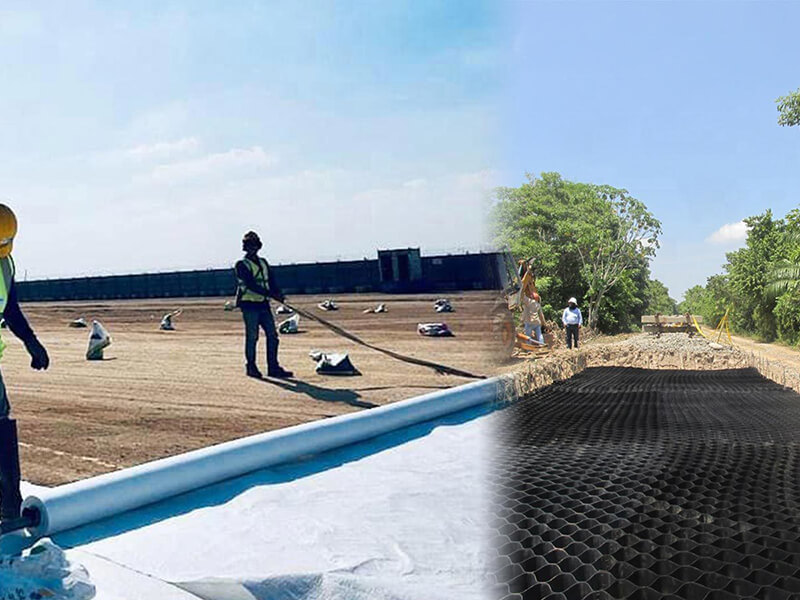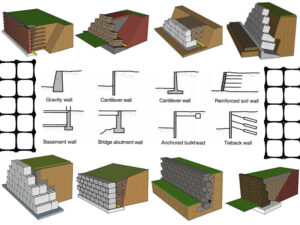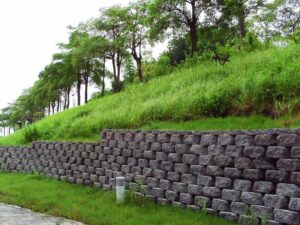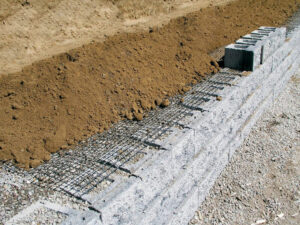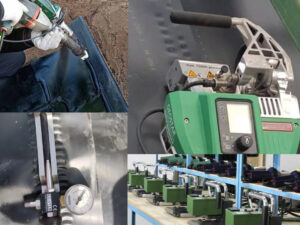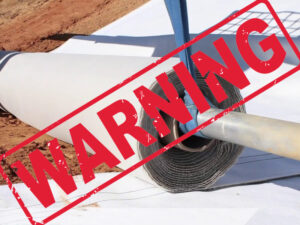Geosynthetics is a general term for synthetic materials used in civil engineering applications. They are chemicals derived from coal, oil, natural gas, or limestone, which are further processed into fibers or sheets of synthetic materials, and finally into various geosynthetic products.
Types of geosynthetics mainly include geotextiles, geomembranes, specialty materials and geocomposites, geonets, fiberglass nets, cushions and so on. Geosynthetics play a vital role in engineering and construction nowadays, providing a cost-effective alternative to traditional methods.
In this article, QIVOC will introduce the types of geosynthetics used in road construction, their uses, benefits, case studies, common problems and solutions. We hope this will help you to understand more about geosynthetics used in road construction.
Types of Geosynthetics Used in Road Construction
Geotextiles
Geotextile belongs to a kind of permeable material. From the perspective of the manufacturing process, it can be divided into two kinds, woven geotextile and non-woven geotextile. The main difference between these two types of geotextiles is whether or not they are woven using machines, and there is no great difference in terms of specific functions and applications. Overall, geotextiles mainly play a filtering function in highway engineering. They are generally used in road construction to help thin the surface layer and prevent reflective cracks.
Case example
In road construction, filament geotextile is often used in road paving.
To improve the smoothness of the road surface, prevent reflection cracks and play the role of a waterproof layer, the filament geotextile is laid between the base layer and the surface layer, and soaked with asphalt to form a filament geotextile-asphalt interlayer, which prevents the base layer from reflecting cracks to the surface layer, and plays the role of the waterproof layer.
A special highway geotextile was added between the asphalt overlay and the old cement silica pavement to prevent reflection cracks.
A reinforced synchronized gravel sealing layer with filament geotextile was used to cover the cracks and prevent leakage.
Because the filament geotextile is used as a treatment material for both the roadbed pavement and the original pavement, it slows down cracks in the gravel seal layer, stabilizes the pavement structure and separates it from the gravel seal layer.
It is waterproof and crack-resistant, which extends the life of the pavement. It does not alter the mix ratio or paving thickness of traditional gravel seals.
Geomembranes
Geomembranes are virtually impermeable and can be divided into asphalt, and polymers from the viewpoint of raw material composition. To achieve a specific deformation, strength standards, and the existence of reinforced, or not. Geomembranes are good geosynthetic materials for filtration, drainage, impermeability and soil retention.
Case example
In the construction of a highway, the project used geomembrane as a waterproof material in the construction of the roadbed. During the construction process, the project team strictly followed the technical requirements and standards of geomembrane laying to ensure the effectiveness and durability of the geomembrane. After years of use, the slight base of the highway is in good condition, with no obvious water erosion and damage, which fully proves the advantages and application value of geomembrane in roadbed construction.
In addition, in other road projects, such as bridges, tunnels and other structures the waterproofing treatment is also widely used in the geomembrane.
Composite Geosynthetics
Composite geosynthetics are products that are a mixture of two or more geosynthetics. It collects the characteristics of different synthesized materials and has wide applicability. It is divided into composite drainage material and composite geomembrane. The latter mainly includes geomembranes and geotextiles. Composite geomembrane has many advantages, especially woven geosynthetic fabric composite, the geomembrane has a good reinforcing function, preventing the membrane from being damaged by external interference, such as transportation or engineering construction. Non-woven fabric composites are also widely used as they reinforce, protect, vent, and drain the membrane and increase the coefficient of friction on the membrane surface.
Case example
Composite geomembrane has a good application effect in road construction. It can effectively prevent groundwater from penetrating the road surface and keep the road dry and stable; it can also insulate water and prevent water from eroding and damaging the soil of the roadbed; it has corrosion resistance and weather resistance, which can prolong the service life of the road. Therefore, it is a very beneficial choice to widely use composite geomembranes in road construction.
Special geosynthetics
In general, special geosynthetics are subdivided into geomembrane bags, geonets, geogrids, fiberglass nets, geomats and so on.
Geogrid, which is mainly made of polymer-polymer materials by the corresponding directional stretching treatment, and then formed a high strength, with open mesh planar mesh material. Geogrid transverse, longitudinal strength uniformity, with good durability, ductility, flexibility, soil resistance, mold resistance, very strong fatigue resistance and filler interlocking.
Geomembrane bags, belonging to a bag-like material, can be used with the template for replacement, mainly in the scour protection project is more common.
Glass fiber mesh to glass fiber-based plane mesh material, high-temperature stability, can prevent and control pavement cracks.
Geonet, mainly composed of strips of synthetic material, is a kind of plane, mesh geosynthetic material. It has good interlocking with the roadbed filler, which can enhance the roadbed strength and prevent the loss of slope surface soil and is mainly used in roadbed and embankment protection projects.
Case example
In a highway construction project of the A1 section. In this section, the embankment of both steep slopes was reinforced with unidirectional tensile high-density polyethylene geogrids. The filling height of the roadbed is 23 m. According to the geological investigation report, the soil quality is soft soil silt with a thickness of 5-6 m. The roadbed is a soft soil foundation. This roadbed project belongs to high filling and high steep slope embankment on a soft soil foundation. To effectively improve the bearing capacity of the soft soil roadbed and reduce its post-work settlement, the roadbed is therefore reinforced with geogrid. The geogrid is set in the filling thickness of 8m, 16m and 20m.
The implementation effect of this project shows that the geogrid has the advantages of high strength, strong bearing capacity, strong durability, convenient construction, long service life, etc., which can be effectively applied in the same kind of project.
3 Engineering Cases of Geogrids Used in Railroad Construction
Use of Geosynthetics in Road Construction
Reinforced
Embankment Reinforcement
To improve the stability of embankment works on special road sections, prevent settlement of embankment and save land, geosynthetics can be chosen to reinforce the embankment and strengthen the treatment.
During construction, geogrids, geotextiles, geonets, etc. are commonly used.
After the embankment is reinforced, the direction of friction formed between the horizontal reinforced surface and the filler material is parallel to the relative displacement direction of the filler material, so that the shear strength of the embankment is enhanced.
In the embankment reinforcement operation, the applied geosynthetics must have good holding power and tensile strength.
To ensure smooth drainage of the embankment so that the geosynthetics are not subjected to chemical corrosion, in the embankment filling operation, it is necessary to lay a sand bedding layer with a thickness of about 40cm on the original surface to enhance the water permeability and then lay the geosynthetics.
In the process of embankment reinforcement, pay attention to the spacing of each layer of geosynthetics, not only to facilitate the construction work, but also to meet the slope protection standards, at least one layer of filler for the minimum compaction thickness, and less than 60cm.
Reinforcement of backfill
Because of the different stiffnesses of the structure crossing the highway project and the structure backfill, it is easy to cause the phenomenon of stepwise uneven settlement.
To prevent the occurrence of “bridge jumping”, it is recommended that geosynthetics be used to reinforce the backfill.
Geosynthetics reinforce the backfill in highway projects, using laying materials, anchorage between structures, and backfill embedded force, contact structures, and backfill, effectively controlling the uneven settlement of the highway.
Filtration and drainage
The stability and strength of roadbed pavement is mainly related to water.
In the construction and maintenance process of roadbed pavement, effective road drainage is required, which is also an important means to ensure the stability of roadbed roads and engineering.
In road engineering construction, geosynthetics and other drainage structures cooperate to form a drainage system, and then smoothly discharge surface water, groundwater and water in the structure.
Utilizing geotextiles in the drainage system also demonstrates the characteristics of fast construction work, simple laying, and low cost.
Geosynthetics can be used alone or mixed with other materials to provide a certain degree of filtration and drainage and can be used in culverts, slope protection of supporting structures and post-wall drainage projects.
Generally, to achieve good filtration effect, non-woven fabrics, or woven geotextiles.
Regarding drainage, non-woven geotextile, or reinforced soft permeable pipe with filter cloth, synthetic fiber and steel ring, and plastic drainage board are available.
Roadbed protection
First, the roadbed is mainly composed of rock and soil, and most of them are exposed to nature, and the mechanical properties are easy to change when they are subjected to external force for a long time.
Therefore, the advantages and disadvantages of the means of roadbed protection are directly related to the stability and strength of the roadbed.
Roadbed protection is mainly divided into two kinds scour and slope.
The plasticity and toughness of geosynthetics are good, and the use of excellent technology to process them into specific shapes is very suitable for application in highway protection projects.
Secondly, do a good job of slope protection, the roadbed of the outer surface of the slope project plays a protective role in preventing rainwater scouring, but also weakens the temperature and humidity sudden change to the project caused by the disadvantage of the outer surface of the weak rock and soil by the external forces to weaken the role of external forces, such as weathering, stripping process, and then make the roadbed more stable.
In the soil slope protection, generally choose to fix the grass seed cloth, tensile network turf, grid fixed sowing and other means. For rocky slope protection projects, usually choose Geogrid or Geonet.
Thirdly, scour protection can control the water flow action on the roadbed produced by the beat, scouring, washing and other impacts, which can prevent the sudden drop in water level leads to the loss of fine materials in the roadbed. The protection of roadbed projects along the river can choose a geotechnical mold bag.
Pavement Crack Control
Geosynthetics can inhibit the continued expansion of cracks due to the contraction of the semi-rigid base layer, reduce rutting in asphalt pavements, and prevent reflective cracks in asphalt paving layers laid on old pavements.
To better manage the cracking problem of the pavement, geotextiles and fiberglass mesh are generally selected.
In the selection of geosynthetics, the following criteria need to be met.
First, heat resistance.
Geosynthetics laid in the semi-rigid grass-roots level and asphalt surface layer in the middle, heat resistance should be consistent with the asphalt surface layer paving standards, to meet the high temperature of 170 ℃ or more.
Second, anti-cracking.
Selection of geosynthetics for dissipation of film. For semi-rigid pavement grass-roots level, there is the problem of cracks, paving materials in the vehicle running under the action of load force, maybe in the cracks at the “arc”, which produces a certain amount of tensile stress, to fight against the tensile stress, geosynthetics must meet the strong tensile standard.
Third, the top-breaking standard.
Geosynthetics in the cracks at the risk of being top broken, especially mixed aggregate semi-rigid grass-roots level, affected by the level of construction technology, easy to form small holes in the normal force conditions, small holes in the laying of the material is easy to be broken, so that the strength of the pavement weakened, geosynthetics to have good extensibility.
Benefits of Using Geosynthetic Materials in Road Construction
Cost-effectiveness is a significant advantage of using geosynthetics in road construction.
Geosynthetics provide a more economical solution compared to traditional construction methods. By reducing the need for expensive materials and labor, geosynthetics help lower the overall cost of road construction projects. Additionally, geosynthetics have a longer service life than conventional materials, resulting in reduced maintenance and repair costs over the lifespan of the road.
Geosynthetics also contribute to improved road performance by enhancing the structural integrity of the pavement layers. Geotextiles and geogrids act as a separators between the different layers of pavement construction, preventing the contamination of base material by subgrade soils. This separation function helps maintain the stability and uniformity of the road structure, leading to better load distribution and extended pavement life.
Furthermore, geosynthetics enhance soil stability in road construction projects. By improving the mechanical properties of the soil, geotextiles and geogrids help prevent soil erosion and settlement, reducing the risk of road failures due to unstable subgrade conditions. Geosynthetics also aid in soil reinforcement, increasing the bearing capacity of the subgrade and providing a more robust foundation for the road surface. This leads to improved road performance, reduced maintenance costs, and enhanced safety for road users.
Geosynthetics Used in Road Construction Case Studies and Examples
The semi-rigid grass-roots level is currently the main structural form of highway pavement project, it has the advantages of high strength, good water stability, rigidity, and deformation, but at the same time it is very difficult to overcome in the construction process —- cracks.
After the grass-roots cracking, it will make the bottom of the asphalt pavement born larger stress concentration, the asphalt pavement is most likely to reflect cracks, it is in such as rain, oxidation, dust, and other environmental factors, which will make the cracks quickly spread to the surrounding area, extension is one of the main reasons for the early destruction of the pavement.
To prevent both the grass-roots cracks reflected the surface layer up, but also to prevent the dual role of surface water infiltration, many engineering reconstructions, maintenance of the use of geotextiles for crack management, and the use of geogrids for the management of soft soil roadbed.
In the road pavement project, geotextile is mainly used in the road surface cover, to prevent the road surface reflection cracks, delay the reflection cracks and carry out.
In roadbed engineering, geogrid is mainly used to deal with soft soil foundations, accelerate the consolidation of the foundation, and improve the bearing capacity of the foundation.
Because of geosynthetics [geotextile and geogrid] has excellent tensile strength characteristics, factory mass production, stable quality and sinking easy construction characteristics, has been widely used in various fields of civil engineering.
FAQ
Pavement structure to prevent reflective cracking of the geotextile should have what characteristics?
1. Good temperature resistance: asphalt mixture hot paving temperature up to 150 ℃ or so, asphalt temperature is higher, the requirement of geotextile in this construction temperature not only can not melt or soften but can maintain normal work. Requirements can withstand temperatures above 170 ℃.
2. good asphalt adsorption: general construction is first evenly sprayed through the layer of asphalt and then paved with geotextile, geotextile should be able to absorb asphalt and saturate, the requirement of geotextile has a good adsorption capacity.
3. good flexibility: flexibility including toughness and surface hardness of two meanings. Toughness reflects the ability of the geotextile to absorb impact energy, which can be approximated by the tensile strength of the material and the product of the elongation measure; generally to CBR test top breaking strength to indicate its surface hardness.
4. good uniformity: geotextile for the various anisotropic materials, to ensure uniform strength, the two-way strength ratio should not be greater than 1.2. generally should be used non-woven geotextile and do not use the preparation of geotextile.
5. aging resistance: geotextile is required to maintain normal working conditions during the service life of the road surface.
6. Thickness requirements: to prevent the addition of geotextile caused by the asphalt surface layer of adverse negative effects (asphalt layer stripping damage), should be strictly limited to the thickness of the geotextile, generally not greater than 2.0mm.
7. water permeability: geotextile also requires good water permeability, which can be measured by the vertical permeability coefficient.
What are the laying methods and requirements of geomembranes during construction?
Geomembrane laying method
1. Geomembrane wall laying
This method is suitable for the occasion that needs to carry out seepage control treatment on the wall. The specific operation is to use glue to fix the geomembrane on the wall, and then welding and sealing treatment.
2. Suspended laying
In this way, the geomembrane is not directly laid on the ground, but suspended on the wire rope or reinforcing steel mesh. This method of laying is suitable for situations where root protection is required.
3. Direct laying
This is the most common way of laying geomembranes. The specific operation is to lay the geomembrane on the foundation or slope, and pay attention to the geomembrane to reserve a certain thickness for welding.
Geomembrane laying requirements
1. Before laying the geomembrane, the ground surface should be cleaned and made clean and flat. 2.
2. when laying the geomembrane, avoid stepping on or pulling the geomembrane, so as not to cause damage to the geomembrane. 3. when welding the geomembrane, avoid stepping on or pulling the geomembrane.
3. when welding, use professional welding equipment to ensure the quality of welding.
4. when laying the geomembrane, pay attention to reducing the number of seams, and handle the seams well to ensure the seepage control effect.
5. When laying the geomembrane, make sure that there are enough weights around it to prevent the geomembrane from being blown away or displaced by wind.
6. Before laying the geomembrane, make sure that it conforms to the specifications and check whether there are any defects such as breakage or cracks in the geomembrane.
What are the specific operation steps in the reinforcement treatment of back-of-platform roadbed fill?
1. Terrain clearing and measurement: First, clear the vegetation and debris in the area of the back of the platform, carry out site leveling, and then carry out accurate measurement and sampling according to the design requirements, and mark out the scope and level of reinforcement.
2. Laying geosynthetics: according to the design drawings, lay geogrids or geotextiles layer by layer from the bottom on the cleaned ground of the back of the platform, make sure that the material is smooth and wrinkle-free, and the edges are firmly anchored.
Make sure the material is smooth, without folds, and the edges are firmly anchored.
3. Layered filling and rolling: on the paved geosynthetics, pave the filler with specified particle size in layers, with the thickness of each layer controlled within a certain range (e.g. not more than 30cm), and use vibratory rollers or heavy rollers to compact the filler in each layer to achieve the specified degree of compaction.
4. Arrangement and fixing of reinforcement bands: If the design includes reinforcement bands (such as plastic bands and steel mesh), lay them at specific levels according to the designed spacing, arrange them staggered with geosynthetics, and fix them in the back of the platform and the filling soil with anchoring nails or tying bands.
5. Quality inspection: Every layer of filling should be inspected for compaction, leveling and elevation to ensure that the quality of filling meets the standard requirements.
Quality Inspection
6. Drainage system setup: In the process of filling, setting up, or reserving roadbed drainage facilities, such as a blind ditch, drainpipe, etc., to ensure the stability of the roadbed and prevent water damage.
7. Layer-by-layer reinforcement and filling: Repeat the above ② to ⑤ steps, layer by layer upward reinforcement and filling until reaching the design height.
8. Slope protection and greening: After the roadbed is filled to the top, carry out slope protection treatment, such as hanging net spraying, masonry slope protection, etc., and carry out greening according to the need to beautify the environment and strengthen ecological protection.
What are the heat resistance and tensile criteria to consider when choosing fiberglass mesh?
The properties of fiberglass fabrics mainly include strength, elongation, heat resistance, chemical resistance, and water resistance. The main considerations for the performance requirements of fiberglass fabrics are as follows:
Strength: transverse and longitudinal tensile strength should be not less than 240N/5cm and 200N/5cm respectively.
Elongation: transverse and longitudinal elongation should be not higher than 5% and 4% respectively.
Heat resistance: it should be able to remain intact at two different temperatures of 121℃ and 260℃.
Chemical resistance: it shall not be eroded and its PH value shall be within the range of 6-10.
Waterproof: It can be treated with waterproofing according to the requirements of users.
Conclusion
Geosynthetics play an irreplaceable role in road construction. It replaces the traditional method of road construction with unparalleled advantages, a wide range of applications, and very low cost. In the future, geosynthetics will have a wider application in road construction.
Now, if you are looking for geosynthetics for road construction, please feel free to contact us, QIVOC will provide you with free technical consultation and the most favorable product price.

